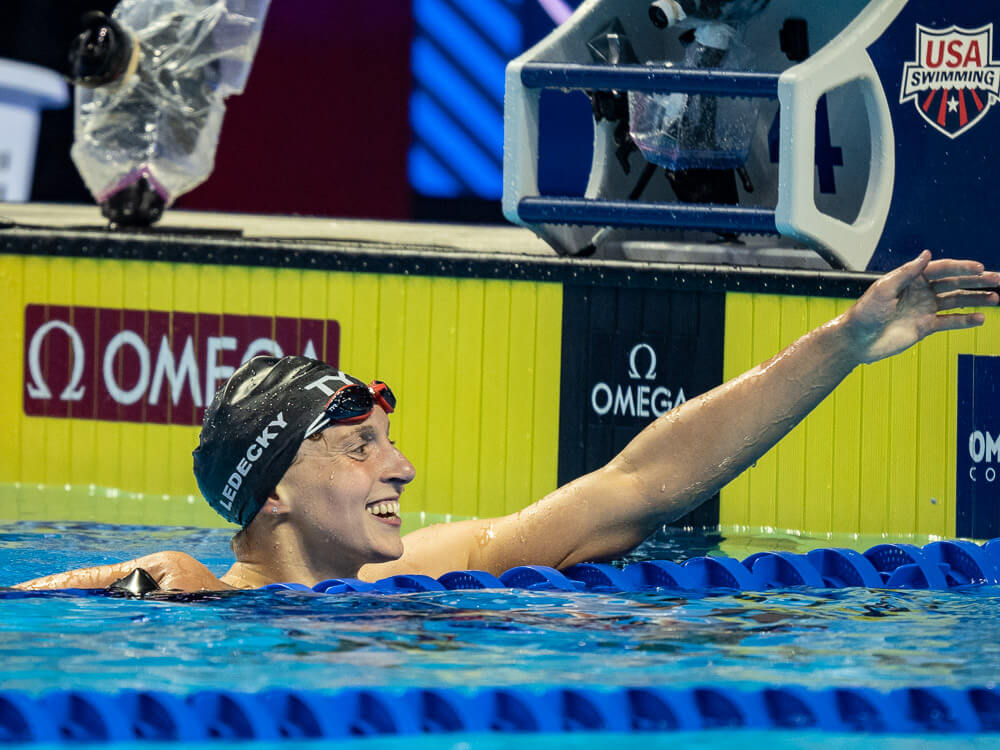U.S. Olympic Trials: Katie Ledecky Makes History As 1500 Freestyle Door Opened to Women

U.S. Olympic Trials: Katie Ledecky Makes History As 1500 Freestyle Door Opened to Women
Flash back to 1984. The scene was Los Angeles, and for the first time in Olympic history, a women’s marathon was contested. Its debut arrived 88 years after the men first raced the event at the inaugural Games in Athens, organizers of the track and field program finally recognizing that 26.2 miles could be handled just as competently by females as their male counterparts.
Joan Benoit was the gold medalist.
Next month, when the Olympic Games are held in Tokyo after a one-year delay due to the COVID-19 pandemic, swimming will have its marathon moment when the 1500-meter freestyle is first offered for women. It has been a men’s event at every Olympics since 1904, but until now, women have only been challenged as far as 800 meters.
Katie Ledecky is the overwhelming favorite to be the inaugural gold medalist.
Completing a grueling double that featured a triumph in the 200 freestyle at the top of the evening, Ledecky cruised to victory in the 1500 free, clocking a championship-record time of 15:40.50. Not only did she prevail by more than 10 seconds over runnerup Erica Sullivan (15:51.18), Ledecky officially earned the right to chase history in Tokyo. Really, an inaugural 1500 free without her would be worthless.
“It’s an event I’ve always enjoyed,” Ledecky said. “We are making history tonight and in Tokyo. That’s fun in its own way and I’ve always enjoyed the training it takes to swim a good mile. It takes a lot mental toughness and strategy. I am pleased with how it went. It was a well put together swim. I didn’t die off or feel like I was dying on the back end.”
In the near decade since she emerged as a 15-year-old Olympic champion at the 2012 Games in London, Ledecky has been the class of the sport – specifically the distance-freestyle events. Until now, though, her 30-lap talent has been limited to the World Championships and select Pro Series meets. When she gets to demonstrate her worth on the Olympic stage, it should be a coronation.
The dominance shown by Ledecky in the metric mile is downright stunning. In addition to owning the 10-fastest performances in history, her world record of 15:20.48 sits 18 seconds clear of the No. 2 performer of all-time, Denmark’s Lotte Friis. To see her anywhere but on the top step of the podium would mean disaster struck.
Earlier in the session, Ledecky bested the field in the 200 freestyle, confirming the defense of her title from the 2016 Olympics in Rio de Janeiro. In that event, Ledecky touched the wall in 1:55.11, the back half of her race the difference. Over the last two laps, Ledecky split 59.03, the only closing 100 under a minute.
As Ledecky moved through the water in the 1500 freestyle, which started 90 minutes after the 200 free, she extended her lead with every stroke. It was a performance featuring power and grace and begged the question: How could women not be given this Olympic opportunity at an earlier time. Especially with the marathon added 37 years earlier, an obtuse view of women’s abilities was clearly taken.
“As a father of four daughters, it’s frustrating that it took this long,” said three-time Olympic gold medalist and NBC broadcaster Rowdy Gaines. “It’s unbelievable. Someone thought women were not strong enough, and 50 years ago, I guess you could understand it, not that I agree with it. It’s a relief (for the athletes). I just feel bad for the generation that didn’t get a chance. At least they’re doing it now.”
With the addition of the 1500 freestyle for women, the International Olympic Committee made the move to add the 800 freestyle for men. Still, a decision could have been made earlier to either add both events, or drop the women’s 800 free in favor of the 1500 freestyle. That approach would have demonstrated an appreciation for equal opportunity.
The lack of the 1500 freestyle as an Olympic event robbed some big names of their chance at glory, such as Americans Debbie Meyer, Kim Linehan and Kate Ziegler. Count Aussies Ilsa Konrads, Shane Gould and Jenny Turall in the group, too. And, of course, we cannot forget Janet Evans, the woman who held the title of greatest distance female before Ledecky came along.
“I’m grateful we have the mile now and I’ve spoken about the equity we have there and that’s the big step,” Ledecky said. “I don’t know how much control I have over the schedule, but the men have it a little easier. I don’t know if they will ever change but I’m game for whatever.”
In nabbing the second position, the 20-year-old Sullivan smashed her personal best and moved ahead of the iconic Evans to become the third-fastest American in event history. Sullivan showed guts from the start, pressing to stay as close to Ledecky as possible. She ultimately held off her Sandpipers teammate, Katie Grimes, who was charging at the finish and touched third in 15:52.12.
The Olympic qualification of Sullivan can be considered a feel-good tale, as she initially was a recruit of the University of Southern California but endured several personal hardships. Not only did Sullivan’s father pass way, she took time to address her mental health and worked on cleaning up some academic issues. Now, she will race in the first Olympic 1500 freestyle for her gender, along with the legendary Ledecky.
“I was supposed to hold it a little bit better and come back a little faster,” Sullivan said. “But I think the adrenaline of the race really amped me up for the first half and I think it set me up in a really good spot where if I did die, which I did, I was in a good spot.
“I’m proud of the mental health barriers that I got through with my dad dying in 2017 and really hitting rock bottom in 2018 (from) the stress of losing a parent at 16 and having to get over the anxiety, the panic attacks, the PTSD and all of that. I’m so happy that I was able to overcome those.”
Results:
1. Katie Ledecky, 15:40.50
2. Erica Sullivan, 15:51.18
3. Katie Grimes, 15:52.12
4. Haley Anderson, 15:55.60
5. Ashley Twichell, 16:01.62
6. Ally McHugh, 16:08.52
7. Sierra Schmidt, 16:08.69
8. Kensey McMahon, 16:20.03


- 2016 USA TRIALS ARCHIVE
- ARCHIVES OF OLYMPIC TRIALS VIA SWIMMING WORLD VAULT
- 2021 USA OLYMPIC TRIALS WAVE I CUTS
- 2021 USA OLYMPIC TRIALS WAVE II CUTS
- HEAD USA OLYMPIC COACHES
- 2016 FULL RESULTS
- WAVE I FULL RESULTS
- PSYCH SHEET
- DAY ONE RESULTS
- DAY TWO RESULTS
- DAY THREE RESULTS
- DAY FOUR RESULTS
- DAY FIVE RESULTS
- DAY SIX RESULTS
- DAY SEVEN RESULTS
- DAY EIGHT RESULTS




Fascinating watching her swim. That one beat kick until the last 50 was amazing to see.
Are we going to celebrate that men will be allowed to swim the 800?
Here’s an idea for an interesting article: comparing when various swimming organizations offered the same events for both sexes. I think that the answer for most summer swim leagues in the United States would be sometime in the 1960s or 1970s. Perhaps from their very first meet. I suspect the same is true for high schools in America. My recollection is that women same the identical events in college as soon as the NCAA took over women’s swimming from the older organization (AAWA or something like that), which used to have women swim 50s of strokes at championship meets in additional to the 100s and 200s. Did the AAU ever have a different program for me and women at championships? Or the YMCA? If so, when did they stop. I think USS Swimming always had the same program at nationals and junior nationals because it did not take over from the AAU until 1975 or so. Obviously, with full access to the swimming world archives, a reporter could figure all of this out for us.
What about other countries? I would think that the Aussies might have always had the same events for men and women at their meets. If not, surely they were probably running the same events for both sexes by the time that Shane Gould was a 10 & under. Or perhaps my guess here is wrong.
It’s hardly surprising, of course, that the IOC is late to the party here. It was much more concerned with covering up what the Commies were doing to their female athletes in the 1970s, 1980s and 1990s than with promoting the same events for both sexes. A nice rousing conclusion to an article documenting this history would be to welcome the IOC aboard to what Western Democracies have been doing for over 50 years. And remind everyone how background and repressive most international organizations are.
While Ledecky was swimming the race she needed to swim (like her coach said, “you can’t win Olympic medals at this meet)” there was a helluva race going on for second – and a much coveted spot at the Games. It didn’t look that way at 1000 meters, but you could see it coming starting at about 11-1200. Unfortunately, NBC didn’t really show it or mention it. It was hard to see because they kept zooming in on Ledecky and talking about her. She, of course, deserves the attention, but there were 7 other competitors working their butts off and 2 in particular that ended up within 1 second of each other (LTB’s for both of them). Congrats to the women who made the team and to all 8 who earned the right to swim for the 2 first-ever Olympic Team spots in the Women’s 1500!